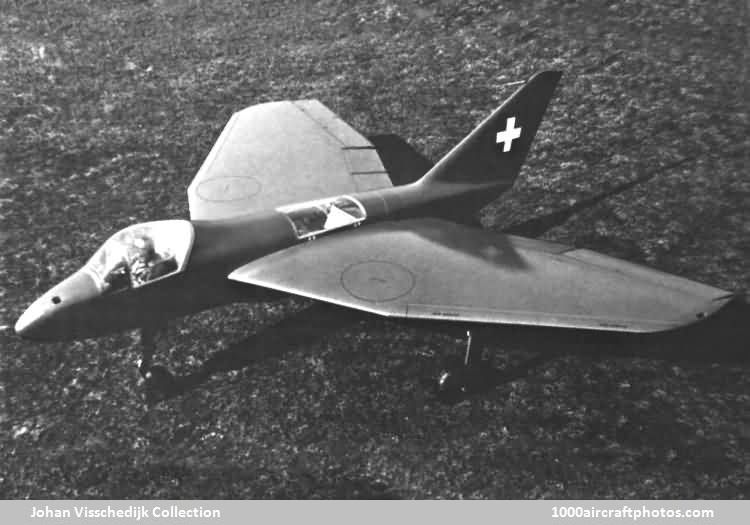09/30/2014. Remarks by Johan Visschedijk: "Near the end of WW II, the engineers of the Eidgenössisches Flugzeugwerk (Federal Aircraft Factory, in short EFW) at Emmen, Switzerland, studied on a future jet fighter design. In 1946, in cooperation with the Swiss AF, a specification was drawn with downright audacious goals. The new aircraft should be equally suitable in the fighter role, for reconnaissance, and for ground attack. It should be in the air after a short take off run, climb in two minutes from 3,281 to 32,810 ft (1,000 to 10,000 m), have near Mach speed, and be more agile than any other aircraft. Various options were open. It was decided that the Dornier works in Altenrhein (later renamed Flug- und Fahrzeugwerke Altenrhein, in short FFA) would focus on a single-engine project (became the P.16), while the EFW would focus on a multi-engine project, the N-20.
The very first designs were revolutionary and deviated from the proven concepts. Of revolutionary design the four-engined EFW type, designated N.20, would have two engines buried in the wing on each side of the fuselage. As it would be a tailless design, a hybrid swept/delta wing was provided. The weapons would be completely housed in a separate pod under the fuselage, which would be replaceable in a few minutes. Finally, a jettisonable cockpit was provided. In case of emergency, a rocket would pull the entire cockpit, including the pilot, away from the aircraft, and after both had separated, the pilot and the cockpit would descend on their own parachutes.
To explore the practicality of the tailless configuration with the swept/delta wing, a 60% scale glider of the later fighter aircraft was built, it featured an observer seat in the fuselage center. Designated N-20.1, it was flown for the first time towed by a C-3604 on April 17, 1948. Unfortunately, before the test program was completed, the experimental aircraft crashed after its 69th flight on July 1, 1949, and was struck off.
Late October 1950 EFW began the construction of a new experimental aircraft, the N-20.2 Arbalète (Crossbow, referring to Wilhelm Tell's 'precision' weapon). This small bright yellow aircraft differed substantially from the N-20.1 glider, while also the observer's seat was omitted. Powered by four miniature 220 lb (100 kg) st Turboméca Piméné jet engines attached to the wings, it became the first Swiss-designed jet aircraft, when it took off from Emmen for its maiden flight on November 16, 1951. Despite being underpowered, the Arbalète showed very promising flying characteristics for the projected N-20.
The construction of the first prototype, designated N-20.10 Aiguillon (Sting), was completed in late 1952, together with its revolutionary Swiss Mamba SM-01 turbofan engine. This was the British Armstrong Siddeley Mamba 1 turboprop rebuilt by the Swiss to a jet engine by replacing the propeller reduction gear by a low pressure compressor. However, the new but limited capacity engines allowed the prototype to make a hop within the length of the runway during high-speed rolling tests on April 8, 1953. The stronger version of the engine was already running on the test bench, however, by mid-1953 funding was exhausted. Additional funding was not to be, as the politicians did not believe in the success of the aircraft, and while a first flight was imminent, the project was axed by an explicit prohibition of continuation from the Head of the Federal Military Department in November.
To testify to the pioneering design and the creativity of the Swiss aircraft industry in the 1940s and 1950s, both the Arbalète and the Aiguillon are preserved: The N-20.2 Arbalète in the Verkehrshaus der Schweiz (Swiss Transport Museum) at Lucerne, and the N-20.10 at the Flieger FLAB Museum, at the Air Force Center at Dübendorf near Zürich, Switzerland."
